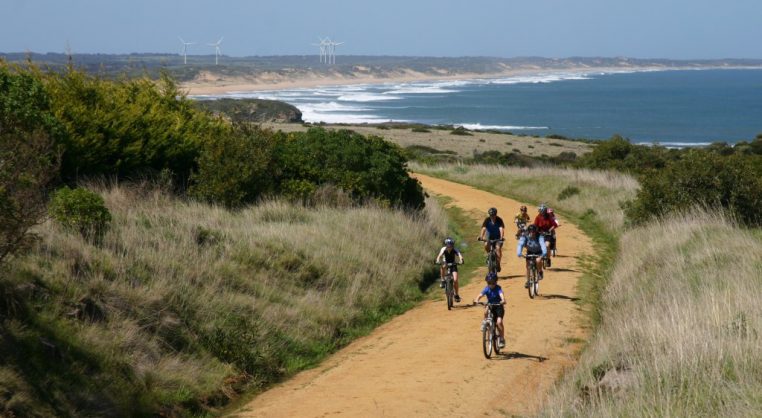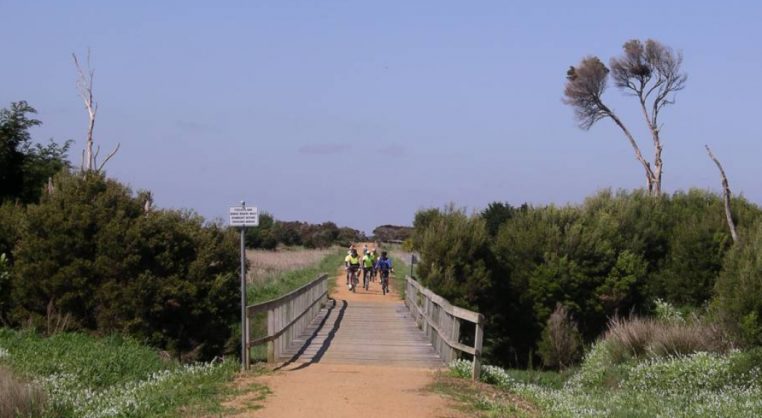The Bass Coast Rail Trail is one of a series of rail trails that reuse defunct railway corridors as linear recreational parks. Located in South Gippsland, the Bass Coast Rail Trail moves through farmland, coastal bushland, historic coal mining reserves and along the Gippsland coastline. The trail has particularly strong links with the area’s coal mining heritage as well as with agricultural heritage.
The trail includes areas of cultural and industrial heritage significance, along with dramatic landscapes and environments of natural and ecological significance. The trail is used for walking, horse riding, cycling and other recreational activities. An important part of the region’s tourist infrastructure, it is also used frequently by local residents, many of whom use it daily.
The trail currently runs from the Anderson Railway Station to the Wonthaggi Railway Station and links to the George Bass Coastal Walk at Kilcunda. There are plans for the future development of the trail to Woolamai, Glen Forbes and Kernot. The section to Woolamai is expected to be completed in 2013, with Glen Forbes in 2014 and Kernot in 2016. Once completed the trail will be 50 kilometres long.
This ongoing, long-term project began in 1994 and continues today. The trail is managed and developed by the Bass Coast Shire Council.
Download a printable version of the Bass Coast Rail Trail Case Study(PDF 562 KB).
Site history and heritage
The Bass Coast Rail Trail is part of a former branch railway from Nyora to Wonthaggi, which opened in 1910 to carry coal from the Wonthaggi State Coal Mine to Melbourne, and to service the region’s farms and agricultural industries.
The coal mine closed in 1968 and, following declining rail usage, the railway itself was closed in 1978. At this time much material and infrastructure was stripped from the site. In subsequent years the neglected site was vandalised.
A series of reports and plans were prepared between 1991 and 1994 looking at the conservation values and proposed development. The Concept Design and Management Plan for the Anderson to Wonthaggi section was completed in 1994, at which time the Bass Coast Council appointed a Committee of Management.
The Wonthaggi Railway Station and the Wonthaggi State Coal Mine, adjacent to the rail trail, are both listed on the Victorian Heritage Register.
Opportunities
The rail line passes through a range of landscapes and includes striking built infrastructure: bridges (including the Bourne Creek timber trestle bridge), a timber rail viaduct, railway stations, remnants of mines and mining activity (including a largely intact mullock heap at Mitchell’s Mine and four miner’s cottages at Wonthaggi).
The trail site is adjacent to the old State Coal Mine at Wonthaggi, Mitchell’s Mine Historic Reserve and the historic cemetery at Kilcunda, coastal reserves and the Wonthaggi Wetlands.
The rail corridor had important remnant vegetation and provided biological corridors between other areas of remnant bush.
Challenges
When the Committee of Management took over in 1994 there was “nothing but clay, blackberries and dead cows” and many of the structures were neglected and unsafe. Licenses and fencing issues had to be negotiated with adjoining landowners.
Approach and outcome
The Bass Coast Rail Trail now forms an important recreational linear reserve, connecting a range of environments and accessing different areas of industrial heritage significance along with many other areas. Interpretation is provided along the length of the trail.
The rail trail is surfaced with fine gravel. Most of the rail tracks were removed when the railway was decommissioned, but the remnant steel lines from the Bourne Creek trestle bridge have been reused as a ‘relic’ at Kilcunda Station. This bridge, one of five repaired, has been adapted to accommodate horse riders as well as walkers and cyclists.
At some points the trail deviates from the path of the rail line – in some cases to ensure the safety of users near busy highways, in others to protect regenerated vegetation.
The development of the rail trail has also been a catalyst for the adaptive reuse of associated historic structures – for example, Wonthaggi station is now a museum, arts and crafts shop – and the trail also brings visitors to adjacent mining heritage sites, such as the State Coal Mine Heritage Area at Wonthaggi.
Solar panel counters at Kilcunda and Wonthaggi track the use of the trail. These indicate an average of 10,000 users per month in the summer peak period and 5,000 to 7,000 at other times.
Maintenance, including weed and vegetation control is a continual expense, as is managing vandalism. The community plays an active role in looking after the trail and providing informal ‘surveillance’. A Friends Group, formed in 2006, helps with marketing and promotion, advice and minimal maintenance.
Lessons
- The rail trail provides public access to the region’s mining and agricultural heritage, while also providing economic and ecological benefits to the community.
- The project demonstrates that industrial heritage includes long, linear sites that connect widely differing environments and heritage contexts.
- The project shows the value of a long-term approach with staged development over decades, including room for growth and change.
Project team
Manager: Bass Coast Shire. Concept plan: Paul Goodison.




